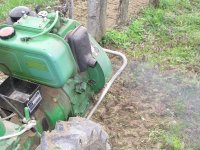julichris:
<font color="blue">I find a single Earthway seeder difficult enough to push, and I think 4 or 5 bolted together would be very straining, at least in our soil, which is silt to clay and fairly compacted. </font>
Although this is a bit off topic, I couldn't help thinking about your comment. I've used the Earthway seeder and they seem to work very well, except for the really small seeds. I have 12 different seed plates and they do a nice job of spacing (reduces thinning) and planting at proper depth. The manufacturer will make up specific plates if needed (or so I've been told). My only criticism of it is that the seeder requires rather exact conditions. Too wet, too much larger clods then it's not so good. It seems to work better, but isn't as heavy as say the old Planet Jr seeders (or something like the Nybex-whew, those are expensive). You're not trying to plant without a nice, fluffy seed bed?
To test your soil (the mechanical condition) fill about 1/3 of a 1 quart mason jar with dirt, top off with water and shake it up real good. Then sit it on a window sill for a day or two. The organic material, being lighter, will float to the top, sand (heavier) will be on the bottom, next up will be silt and on top of that, the clay particles. There should be a fairly fine division/line between the different constituent parts of the soil structure. You can then make an estimate of the percentages of the different material. If the sand, for example, is too little dump an inch or two and till it in. If the mechanical condition is well balanced, and the ground is well tilled and fluffy, the plants will grow better and the seeding should be easy.
Actually, I tend to like transplanting. Transplanting already started plants into fresh tilled ground (no weeds started) gives the crop a head start, reduces weeding etc. The only thing I don't like about that is using those plastic trays (makes it harder to transfer/set out). I bought a couple soil block makers in a couple sizes recently and will try those next year. Supposedly, can simply lift the blocks off a board with a trowel and drop in the hole. Small blocks (for making the holes) can be mounted to an open roller (spaced as required) which is towed behind the tiller. One pass leaves everything fluffy, properly spaced holes and ready for transplanting/setting out. We'll see.
JEH
PS ZJ_HR the rotary plow on the gravely was in front, on the BCS (and European 2 wheelers) is driven with the PTO in the rear facing position.



